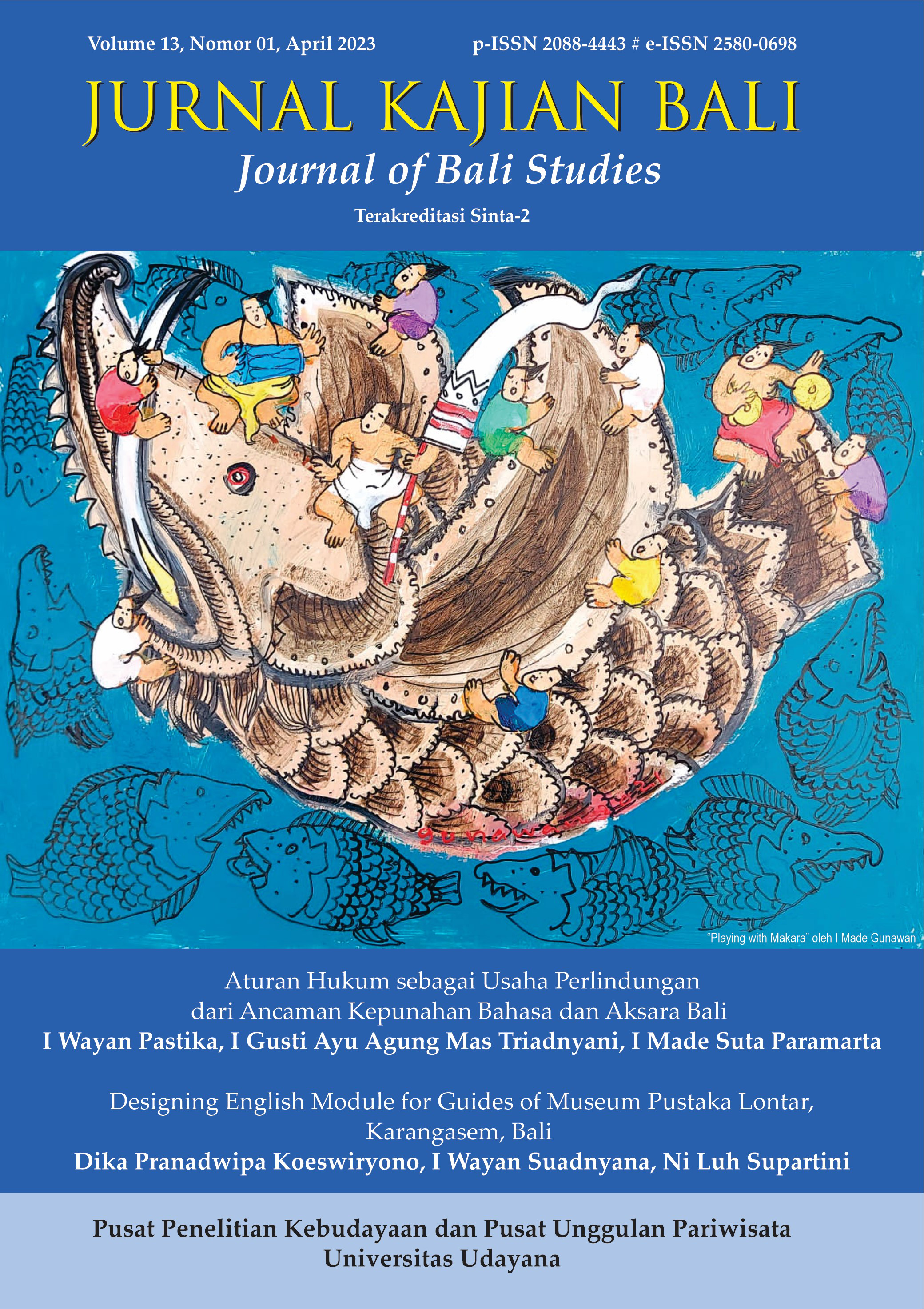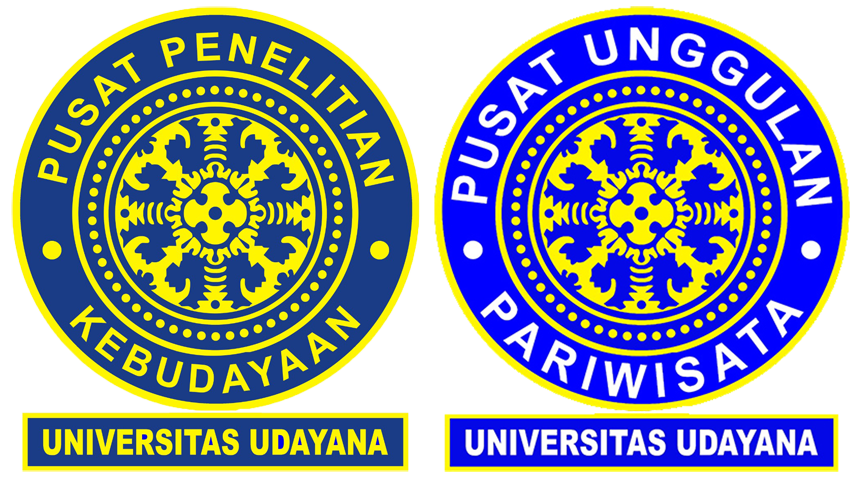Budaya, Relasi Kekuasaan dan Pengembangan Gaya Arsitektur: Preseden Rancangan Kawasan Kota Denpasar
Abstract
A work of architecture has historical significance and serves as a cultural artifact. This work reflects the personality of a specific neighborhood or city. Identity carries a variety of connotations because it is a fundamental and necessary aspect of upholding cultural values and a nation's dignity. Rapid urbanization, on the other hand, frequently results in regional development that is unrelated to the region's historical factors or the sustainability of the region's culture. This paper seeks to establish an architectural precedent for developing a city area cultured as a heritage city by conducting field surveys and graphically analyzing architectural documents, as well as a historical analysis of power relations in the Denpasar urban area, particularly the former Denpasar palace area. In this case, a combination of traditional and colonial architectural styles is used as a design reference and precedent for the future development of urban areas.
Downloads
References
Adhika, I. M., & Putra, I. D. G. A. D. (2021). Reinvigorating cultural landscapes for planning cultural tourism in Bali. Geojournal of Tourism and Geosites, 33(4), 1462–1469. https://doi.org/10.30892/gtg.334spl03-594
Agung, A. A. G. P., Parimartha, I. G., Budharta, I. B. G., & Rama, I. B. (1986). Sejarah Kota Denpasar 1945 - 1979. Departemen Pendidikan dan Kebudayaan. http://repositori.kemdikbud.go.id/8207/1/SEJARAH KOTA DENPASAR 1945-1979.pdf
Amin, A., & Thrift, N. (2007). Cultural-economy and cities. Progress in Human Geography, 31(2), 143–161.
Bıçakçı, A. B. (2012). Branding the city through culture : Istanbul , European. International Journal of Human Sciences, 9(1), 13–17.
Brubaker, R., & Cooper, F. (2000). Beyond" identity". Theory and Society, 29(1), 1–47.
Brunn, S., & Williams, J. F. (1983). Cities of the World: Regional Urban Development. Harper and Row.
Budihardjo, E. (1986). Architectural conservation in Bali. Gajah Mada University Press.
Castree, N. (2004). Differential geographies: Place, indigenous rights and “local” resources. Political Geography, 23(2), 133–167. https://doi.org/10.1016/j.polgeo.2003.09.010
Checa-Artasu, M. M. (2015). The Catholic Church and Neo-Gothic Architecture in Latin America: Scales for Their Analysis. In S. D. Brunn & D. A. Gilbreath (Eds.), The Changing World Religion Map: Sacred Places, Identities, Practices and Politics (pp. 2437–2451). Springer. https://doi.org/10.1007/978-94-017-9376-6
Claval, P. (1995). Space and creativity.«Belle Epoque» Paris: Genesis of a World-class artistic centre. In Geography, history and social sciences. (pp. 133–142). Springer.
Colomb, C. (2011). Culture in the city, culture for the city? The political construction of the trickle-down in cultural regeneration strategies in Roubaix, France. Town Planning Review, 82(1), 77-98.
Dinas Tata Kota dan Bangunan Kota Denpasar, (2006). Laporan Penataan Kawasan Heritage Jalan Gajahmada, Denpasar: Pemerintah Kota Denpasar.
Dovey, K. (2009). Becoming places: urbanism/architecture/identity/power. Routledge.
Dua, M. (2017). Globalisasi Ekonomi, Budaya Kapitalis dan Demokrasi. Jurnal Ledalero, 12(2), 355–372.
Erikson, E. H. (1968). Identity: Youth and crisis (Issue 7). WW Norton & company.
Evans, G. (2001). Cultural Planning: An Urban Renaissance? Taylor & Francis e-Library.
Firzal, Y. (2020). Redefining urban architecture in the decentralization era. AIP Conference Proceedings, 2230(1), 40004.
Florida, R. (2002). The Rise of the Creative Class. Basic Books.
Garcia, B. (2004). Cultural policy and urban regeneration in Western European cities: lessons from experience, prospects for the future. Local Economy, 19(4), 312-326.
Gauldie, S. (1969). Architecture: The Appreciation of the Arts. Oxford University Press.
Geertz, C. (1980). Negara. Princeton University Press.
Gelebet, I. N. (1998). Arsitektur Tradisional Bali (Balinese Traditional Architecture). Bappeda Bali.
Gibson, L., & Stevenson, D. (2004). Urban space and the uses of culture. International Journal of Cultural Policy, 10(1), 1–4.
Gil, P. (1999). El templo del siglo XX. Editorial Serbal; Collegi d’arquitectes de Catalunya.
Gleeson, B. 2003. (2003). Reflexive Modernization: The Re-Enlightenment of Planning? International Planning Studies, 5(1), 117–135.
Griffiths, R. (2006). City-culture discourses: Evidence from the competition to select the European capital of culture 2008. European Planning Studies, 14(4), 415–430.
Griffiths, R., Bassett, K., & Smith, I. (2003). Capitalising on culture: cities and the changing landscape of cultural policy. Policy & Politics, 31(2), 153-169.
Guney, A. (2008). Architectural precedent analysis — A cognitive approach to morphological analysis of buildings in relation to design process. In K. M. M. Zarzar & A. Guney (Eds.), Understanding meaningful environments — Architectural precedents and the question of identity in creative design (pp. 91–115). IOS press.
Handinoto. (1996). Perkembangan Kota dan Arsitektur Kolonial Belanda di Surabaya 1870 – 1940.
Harahap, F. R. (2013). Dampak Urbanisasi Bagi Perkembangan Kota Di Indonesia. Society, 1(1), 35–45. https://doi.org/10.33019/society.v1i1.40
Hardy, I. G. N. W., Setiawan, B., & Prayitno, B. (2016). Pengaruh Sistem Catur Wangsa terhadap Perwujudan Tata Spasial Kota Peninggalan Kerajaan Hindu di Bali: Kasus Kota Karangasem. Jurnal Kajian Bali, 06(02), 79–96.
Immler, N. L., & Sakkers, H. (2014). (Re)Programming Europe: European Capitals of Culture: Rethinking the role of culture. Journal of European Studies, 44(1), 3–29. https://doi.org/10.1177/0047244113515567
Ismail, A. S. (2014). Architecture as an Expression of Political Ideology. Faculty of Built Environment, Universiti Teknologi Malaysia, Malaysia.
Ismail, A. S., & Alice, D. (2008). Discourse of Democratic Architecture in Malaysia: An Analysis of Putrajaya Government Building in Comparison to Parliament Building. Engaging Malaysia Modernity, 50.
Jong, T. M. de, & Voordt, D. J. M. van der. (2002). Ways to study and research — Urban, architectural and technical design,. DUP.
Kavaratzis, M. (2011). The Dishonest Relationship Between City Marketing and Culture: Reflections on the theory and the case of Budapest. Journal of Town and City Management, 1(4), 334-345.
Klaasen, I. T., & Witberg, M. J. J. (1993). Het stromend stadsgewest — Vormgeven aan de ecoregio Breda — Derde Eo Wijers–prijsvraag — Plananalyse. TUDelft.
Kraft, S. (2013). "Architecture is the mirror of every historical moment, we can see our time reflex on the buildings of our cities.“ Interview with Daniele del Nero. Deconarch.Com. http://www.deconarch.com/architecture-is-the-mirror-of-every-historical-moment-we-can-see-our-time-reflex-on-the-buildings-of-our-cities-interview-daniele-del-nero/
Lähdesmäki, T. (2014). European Capital of Culture Designation as an Initiator of Urban Transformation in the Post-Socialist Countries. European Planning Studies, 22(3), 481-497.
Landry, C. (2000). The Creative City: A Toolkit for Urban Innovators. Earthscan.
Landry, C. (2006). The art of city-making. Sterling, VA: Earthscan. Sterling, VA: Earthscan.
Lefèbvre, H. (1992). The Production of Space. Blackwell.
McGee, T. G. (1967). The Southeast Asians City: A Social Geography of the Primate Cities of Southeast Asia. G. Bell and Sons.
Miles, M. (2007). Cities and cultures. In Cities and Cultures. https://doi.org/10.4324/9780203001097
Miles, S., & Paddison, R. (2005). Introduction: The rise and rise of culture-led urban regeneration. Urban Studies, 42(5–6), 833-839.
Monnet, J. (2011). The symbolism of place: A geography of relationships between space, power and identity. Cybergeo: European Journal of Geography.
Muijzenberg, van den, Otto, & Wolters, W. (1988). Conceptualizing Development of the Historical-Sociological Tradition in Dutch Non-Western Sociology.
Nordholt, H. G. C. S. (1986). Bali: Colonial conceptions and political change 1700-1940. From shifting hierarchies to fixed order.
Nordholt, H. S. (1991). The jago in the shadow. Crime and “order” in the colonial state in Java. In R I M A: Review of Indonesian and Malaysian Affairs: a semi-annual survey of political, economic, social and cultural aspects of Indonesia and Malaysia (Vol. 25, Issue 1, pp. 74–91).
Noviyanti, R. (2021). Revolusi Industri dan Pengaruhnya pada Penelitian Sejarah. Alur Sejarah: Jurnal Pendidikan Sejarah., 4(2), 1–8.
Nursyahbani, R., & Pigawati, B. (2015). Kajian Karakteristik Kawasan Pemukiman Kumuh Di Kampung Kota (Studi Kasus: Kampung Gandekan Semarang). Teknik Perencanaan Wilayah Kota, 4(2), 267–281.
Paramitha, I. A. D., Kastawan, I. W., & Widiastuti. (2017). Nilai Signifikansi Cagar Budaya Hotel Inna Bali Jalan Veteran Denpasar. Space, 4(3), 113–128.
Parimin, A. P. (1986). Fundamental study on spatial formation of island village: environmental hierarchy of sacred-profane concept in Bali. 大阪大学.
Pasman, G. J. (2003). Designing with precedents, . Faculty of Industrial Design.
Picard, M. (1996). Bali: cultural tourism and touristic culture. Archipelago Press.
Pranowo, L. (2014). Tipologi Fasad Art Deco pada Bangunan-bangunan di Yogyakarta. Universitas Gadjah Mada. Yogyakarta.
Pratt, A. C. (2010). Creative cities: Tensions within and between social, cultural and economic development a critical reading of the UK experience. City, Culture and Society, 1(1), 13–20. https://doi.org/10.1016/j.ccs.2010.04.001
Prestel, J. Ben. (2016). Paris Everywhere? The Challenge of Eurocentrism in Global Urban History. www.globalurbanhistory.com.
Putra, I. D. G. A. D., Lozanovska, M., & Fuller, R. (2013). The Transformation of the Traditional Balinese House for Tourist Facilities: Managing a Home-Based Enterprise and Maintaining an Architectural Identity. Asia Pacific Management and Business Application, 2(2). https://doi.org/10.21776/ub.apmba.2013.002.02.4
Putra, I. D. G. A. D., Lozanovska, M., & Fuller, R. (2019). From spiritualistic toward more pragmatic pattern: Re-ordering Balinese houses and viability of the household traditions in the tourism economy. Journal of Architecture and Urbanism, 43(1). https://doi.org/10.3846/jau.2019.3692
Putra, I. D. G. A. D., & Wirawibawa, I. B. G. (2020). The Balinese Palaces in Gianyar : Representing Authority Power and Creating Territorial Identity. International Journal of Innovation, Creativity and Change, 14(8), 132–150.
Putra, I. G. M. (2005). Catuspatha, Konsep, transformasi dan Perubahan. Journal Permukiman Natah, 3(2), 62–101.
Rao, H., Monin, P., & Durand, R. (2003). Institutional change in Toque Ville: Nouvelle cuisine as an identity movement in French gastronomy. American Journal of Sociology, 108(4), 795–843.
Sacco, P. L., Blessi, G. T., & Nuccio, M. (2009). Cultural policies and local planning strategies: what is the role of culture in local sustainable development? Journal of Arts Management, Law, and Society, 39(1), 45–64.
Sacco, P. L., & Crociata, A. (2013). A conceptual regulatory framework for the design and evaluation of complex, participative cultural planning strategies. International Journal of Urban and Regional Research, 37(5), 1688–1706. https://doi.org/10.1111/j.1468-2427.2012.01159.x
Sasmita, T. (2020). Potential of Denpasar City “Zero Point” for Denpasar City Tour Package Development. Advances in Economics, Business and Management Research, 111, 99–102. https://doi.org/10.2991/icoborot-18.2019.15
Satria, M. W., & Putra, I. D. G. A. D. (2020). The Kori Agung Character of Heritage Temples: The Architectural References of Klungkung Identity. Journal of Social and Political Sciences, 3(1).
Schön, D. (2009). The reflective practioner — How professionals think in action. Ashgate Publishing.
Seramasara, I. G. N., & Trisnawati, I. A. (2019). Bali’s cultural arts and the contest of identity during the tourism era of Bali. International Journal of Innovation, Creativity and Change, 9(4), 109–120.
Setyowati, A. D. (2011). Pengaruh Industrialisasi dan Pertumbuhan Penduduk Terhadap Proses Urbanisasi di Jawa Tengah Tahun 1990-2005. Universitas Sebelas Maret Surakarta.
Stevenson, D. (2004). Civic Gold Rush. Cultural planning and the politics of the Third Way. International Journal of Cultural Policy, 10(1), 119-131.
Sumalyo, Y. (1993). Arsitektur Kolonial Belanda di Indonesia. Gadjah Mada University Press.
Suyadnya, I. (2011). Securitization, Belonging and Politics of Belonging in Bali. Jurnal Kajian Bali, 1(1), 73–87.
Tarnutzer, A. (1995). Kota Denpasar: 'The Making of a Balinese Colonial Town’,. In B. Werlen & S. Wälty (Eds.), Kulturen und Raum: Theoretische Ansätze und empirische Kulturforschung in Indonesien (pp. 245–265). Verlag Rüegger AG.
Tjiptoherijanto, P. (2016). Urbanisasi Dan Pengembangan Kota Di Indonesia. Populasi, 10(2), 57–72. https://doi.org/10.22146/jp.12484
Tretter, E. M. (2009). The cultures of capitalism: Glasgow and the monopoly of culture. Antipode, 41(1), 111–132. https://doi.org/10.1111/j.1467-8330.2008.00658.x
Triyuni, N. N., Ginaya, G., & Suhartanto, D. (2019). Catuspatha Spatial Concept in Denpasar City : Toward Multiculturalism and Cultural Tourism. International Journal of Linguistics, Literature and Culture, 5(3), 18–31. https://sloap.org/journals/index.php/ijllc/
Tzonis, A. (1992). Huts, ships and bottle racks — designed by analogy for architects and/or machines. In N. Cross, K. Dorst, & N. Roozenburg (Eds.), Research in design thinking (pp. 139–164). Delft University Press.
Vakili-Ardebili, A., & Boussabaine, A. H. (2006). Quality concept in Persian precedent architecture: A lesson in eco-building design. PLEA 2006 - 23rd International Conference on Passive and Low Energy Architecture, Conference Proceedings, September, 6–8.
Van Oers, B. (1998). From context to contextualizing. Learning and Instruction, 8(6), 473–488. https://doi.org/10.1016/S0959-4752(98)00031-0
Vickers, A. (1996). Modernity and being modern: an introduction. In A. Vickers (Ed.), Being modern in Bali: image and change (pp. 1–37). Monograph 43/ Yale University Southeast Asia Studies.
Weber, K., Heinze, K. L., & DeSoucey, M. (2008). Forage for thought: Mobilizing codes in the movement for grass-fed meat and dairy products. Administrative Science Quarterly, 53(3), 529–567.
Wertheim, W. F., & Kraal, J. F. (1958). Indonesian Town: Studies in Urban Sociology. van Hoeve, The Hague and Bandung.
Wiener, M. J. (1995). Visible and Invisible Realms: Power, Magic, and Colonial Conquest in Bali. University of Chicago Press.
Wiryomartono, A. B. (1995). Seni Bangunan dan Seni Bina kota di Indonesia. Penerbit PT Gramedia Pustaka Utama.
Worsley, P. (2019). The Rhetoric of Paintings: Towards a History of Balinese Ideas, Imaginings and Emotions in the Late Nineteenth and Early Twentieth Centuries. Jurnal Kajian Bali (Journal of Bali Studies), 9(1), 35. https://doi.org/10.24843/jkb.2019.v09.i01.p02
Wry, T., Lounsbury, M., & Glynn, M. A. (2011). Legitimating nascent collective identities: Coordinating cultural entrepreneurship. Organization Science, 22(2), 449–463.
Yudantini, N. M., Darma, K. A. S., & Wiryawan, W. (2017). Sejarah dan Perkembangan Kota Denpasar sebagai Kota Budaya. Seminar Ikatan Peneliti Lingkungan Binaan Indonesia (IPLBI), 1, B177–B184. https://doi.org/10.32315/sem.1.b177
Yulianto, A., & Wibowo, K. (2017). Pengaruh Jalan Lingkar Luar terhadap Perkembangan Wilayah di Kota Palangkaraya Ditinjau dari Tata Guna Tanah. Prosiding Seminar Nasional Inovasi Dalam Pengembangan SmartCity., 1(1), 94–107.
Yusiana, L. S. (2016). Konsep Interpretasi Guna Melestarikan Tapak Sejarah di Pecinan Jalan Gajah Mada, Denpasar. Jurnal Arsitektur Lansekap, 2(2), 165. https://doi.org/10.24843/jal.2016.v02.i02.p07
Zhuanqing, C. (2010). The Strategic Research on Zhongyuan Culture and City Brand Marketing. The International Marketing Science and Management Technology Conference.

This work is licensed under a Creative Commons Attribution 4.0 International License.



















